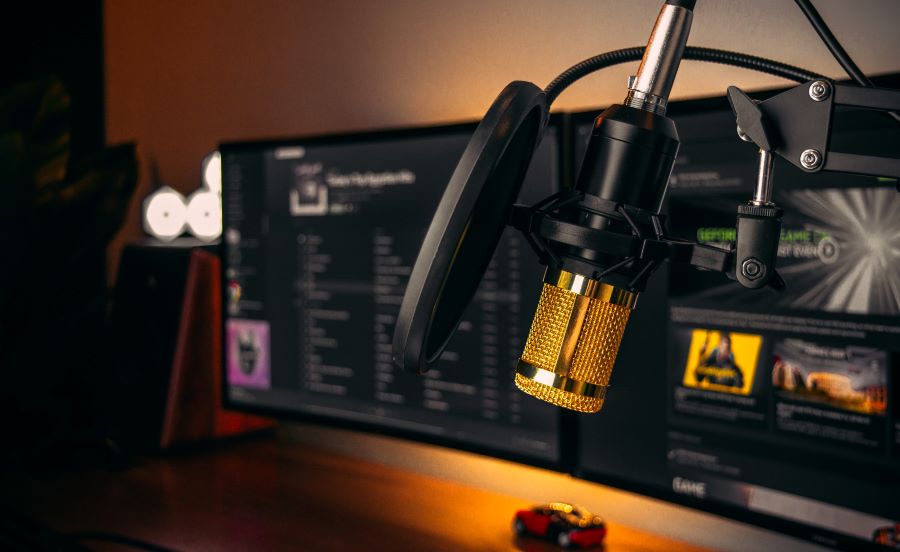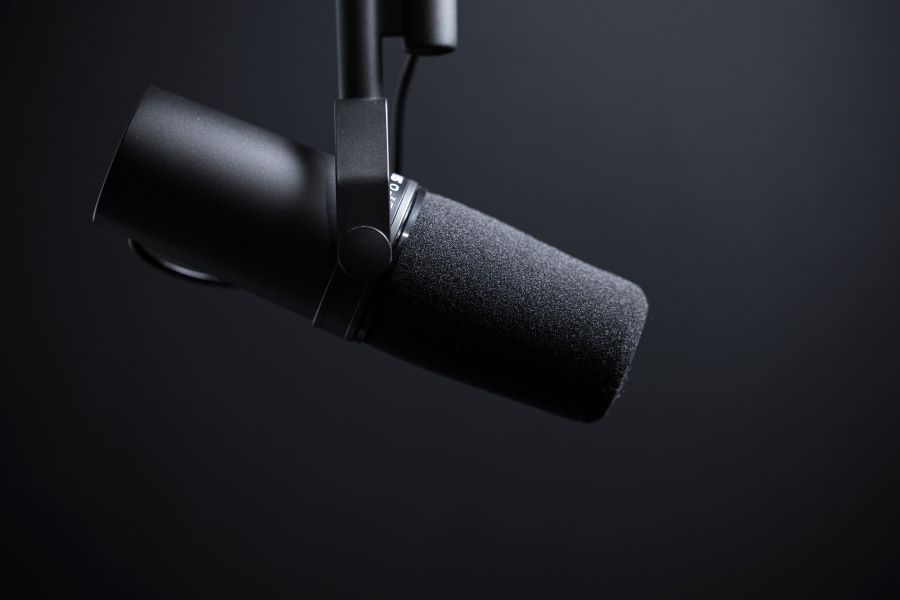If you’re a podcaster, you know how important it is to have a good pop filter. But which one is better for you? Who wins the pop filter vs foam cover discussion?
This blog post will compare the two and help you decide which one is best for your needs. Stay tuned!
Contents
Pop Filter
What Is It?
A pop filter is a microphone device to reduce popping noises caused by P-pops and S-sounds (Aka plosive sounds). These noises are created when air from the mouth hits the microphone diaphragm at close range, producing a burst of sound and distorting the recording.
The pop filter is usually a circular or triangular-shaped mesh screen placed in front of the microphone. It acts as a windscreen to deflect any bursts of air from hitting the diaphragm, thus preventing them from being recorded.
Features
There are many different types of pop filters available on the market, but they all have the same basic function. Here are some features of pop filters:
Reduces popping noises
Any singer or podcaster knows the importance of a good pop filter. As the name suggests, a pop filter is designed to reduce popping noises when recording vocals. A pop filter helps to produce a clean, clear recording by deflecting the air that hits the microphone’s diaphragm. Pop filters are an essential tool for anyone serious about achieving professional-quality audio.
It can be used with any microphone
Pop filters are not specific to any microphone. Popping noises are lessened when you use a pop filter, whether your microphone is dynamic or condenser. This makes them an ideal solution for both studio and live recordings.
Improves audio quality
In addition to reducing popping noises, pop filters can also help improve your audio recordings’ overall quality. By providing a physical barrier between the microphone and the mouth, pop filters help to minimize unwanted sounds such as plosives and sibilance. As a result, your recordings will sound cleaner and more polished.
Affordable
Pop filters are affordable, making them an excellent investment for anyone serious about recording high-quality audio. Prices start at around $10, making them a great way to improve your recordings without breaking the bank.
Easy to use
Pop filters are extremely easy to use. Attach the filter to your microphone stand and position it. Most pop filters come with adjustable arms to position them exactly where you need them. Once in place, the pop filter will do its job without requiring further adjustments.
Foam Cover
What Is It?
A foam cover is a type of microphone cover that helps to protect the microphone from moisture and other forms of contamination. It covers the entire microphone. It is made from a closed-cell foam designed to be breathable so that it does not interfere with the microphone’s sound quality.
The foam cover can be used to protect any microphone, and it is typically placed over the head of the microphone when it is not in use. This helps to keep the microphone dry and clean, and it also helps to reduce wind noise when the mic is being used outdoors.
Features
There are many different types of foam covers available on the market, but they all have the same basic function. Here are some features of foam covers:
Breathable
When looking for a foam cover, breathability is an important feature to consider. The closed-cell foam used to make foam covers is designed to be breathable so that it does not interfere with the microphone’s sound quality. This means that the microphone can pick up the sound without the distortion caused by the foam cover.
Moisture-resistant
Foam covers are also moisture-resistant, which can help protect the microphone from condensation and other forms of moisture. This is especially important if you use the microphone in a humid environment. The foam cover will help keep the moisture away from the microphone so it can continue to function properly.
Wind noise reduction
Another benefit of foam covers is that they can help to reduce wind noise. This is because the dense network of blades on the foam cover helps to deflect wind away from the microphone. This can be helpful in situations where you are trying to avoid picking up the unwanted background noise.
Universal fit
Most foam covers are designed to fit a wide range of different microphones. This means that you should be able to find a foam cover that will fit your specific microphone model. If you are unsure what size you need, it is always best to check with the manufacturer before making a purchase.
Easy to clean
Foam covers are also easy to clean, which is helpful if you use your microphone in dusty or dirty environments. The closed-cell foam used to make foam covers is resistant to dirt and dust, so all you need to do is wipe it down with a clean cloth when it gets dirty. You should also avoid using harsh cleaners or solvents on the foam cover as this could damage it.
Pop Filter Vs Foam Cover: Differences & Similarities
There are two main types of microphone covers: foam covers and pop filters. Both serve the purpose of protecting your microphone from damage, but they do so in different ways.
Here are the key differences and similarities between foam covers and pop filters:
- Pop filters reduce plosives, while foam filters reduce overall noise. Pop filters are typically made of metal mesh and stretched over an aluminum frame, while foam filters are made of, well, foam windscreen.
- The indoor recording is much more convenient with pop filters and foam windscreens. We recommend using both, as they are quick to set up! You can’t do without a good filter in your studio.
- A pop filter is an important tool for recording, but it can’t be used outdoors or if you’re on the go. In those cases, we recommend using some mic foam to muffle any pops in your audio that might happen due only to windy conditions.
How to Choose the Right Cover for Your Microphone?
Now that you know the difference between foam covers and pop filters, it’s time to choose the right one for your needs. Here are factors to consider:
- Do you need a filter for indoor or outdoor recording? If you are recording indoors, we recommend using a pop filter. If you are recording outdoors or on the go, we recommend using foam.
- What’s your budget? Pop filters are typically more expensive than foam covers. But if you’re looking for quality, it’s worth the investment.
- What’s your recording style? A pop filter is a must-have if you’re a podcaster or YouTuber. But a foam cover might be all you need if you’re starting.
- Do you have any allergies? If you’re allergic to latex, we recommend using a foam cover instead of a pop filter.
- What’s the size of your microphone? If you have a large microphone, we recommend using a foam cover. A pop filter or foam cover will do if you have a small microphone.
- What’s your recording environment? We recommend using nylon pop filters if you’re recording in a quiet room. If your recording studio is noisy, we recommend using foam.
Consider the factors above to make the best decision for your needs. And remember, you can always use both a pop filter and foam mic cover for the ultimate protection!
Choosing a Mic with Pop Filter
Here are a few things to remember when choosing a microphone with a pop filter:
- Consider your budget. Pop filters can range in price from $10 to $100. We recommend looking for a cheaper option if you’re on a tight budget. But if you can afford it, we recommend investing in a quality pop filter.
- Consider the size of the mic. Some pop filters are designed for specific microphone sizes. Check the product description to see if the filter you’re considering will fit your microphone.
- Consider the material of the mic. Some materials are more effective at reducing pops than others. We recommend looking for a pop filter made of metal or mesh. Metallic mesh pop filters are more expensive than nylon mesh pop filters, yet they are worth it!
- Consider the quality. Some pop filters are better than others at reducing pops. We recommend looking for a high-quality pop filter if you can afford it.
- Consider your needs. You might not need a pop filter if you’re only recording yourself. But if you’re recording multiple people or if you’re recording in a noisy environment, we recommend using a pop filter.
Related: Pop Filter For Blue Yeti
Choosing a Mic with Foam Cover
There are a few things to remember when choosing a microphone with a foam cover. Here are our top tips:
- Consider the size and shape: The size and shape of the microphone are important factors to consider. Make sure the foam cover will fit snugly around the microphone.
- Think about sound quality: The foam cover should not affect the microphone’s sound quality. If you’re unsure, ask a salesperson for help.
- Choose the right material: The foam material is also important. Make sure it’s durable and will not tear easily.
- Consider the price: Foam covers can range in price, so consider your budget when purchasing.
When choosing a microphone with a foam cover, these are a few things you’ll want to keep in mind. After you have decided if you need a foam cover or a pop filter, check our the best microphones for podcasting to make sure the microphone you own or plan to own works well with it.
Conclusion
So, which one is better for you? A pop filter vs foam cover? Well, it depends on your needs. A pop filter is a way to go if you’re looking for something to protect your microphone from wind and popping sounds.
However, a foam cover would be best if you want to reduce echoes and minimize background noise. The bottom line is that you must choose the kind of security that will work in your particular case.
Do you have any tips about using a pop filter vs foam cover? Let us know in the comments below!

